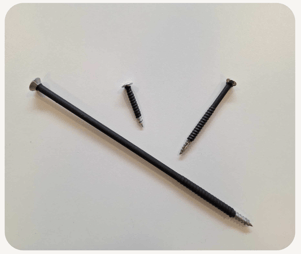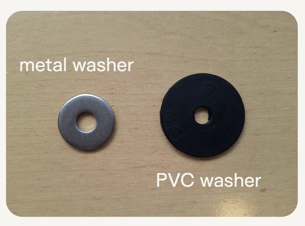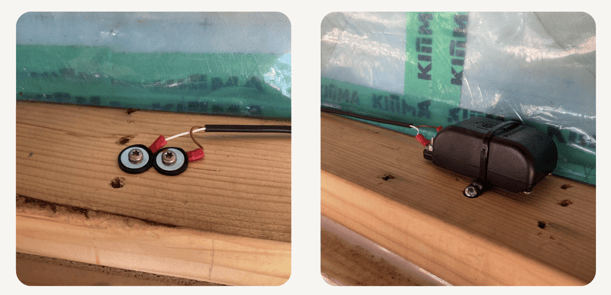How to install sensors directly on timber
Step-by-step guide to installing Tector sensors on timber
The basic steps for installing Tector sensors on timber are straightforward, but customizations may be necessary depending on your measurement needs. Follow these basic steps and refer to the customization section as needed.
Basic installation steps
1. Identify location- Choose the appropriate location on the timber where the sensor will be installed.
2. Mount the sensor
- Use the accompanying screws to mount the sensor.
- Ensure the head of the screw makes contact with the metal plate in the eyes of the sensor.
- Ensure the pins are not measuring across panels of timber, such as in LVL (Laminated Veneer Lumber).

- Scan the QR code with your phone’s camera and follow the setup instructions.
- Fill out the location details, choose the sensor type, and upload two photos: one from a distance and one from +2 meters away.
- Fill out tags or copy from previously installed sensors.
- Note the sensor’s placement and ID on a physical blueprint, then attach the sensors to the corresponding locations on the digital blueprint in the application on your computer.
Customization instructions
Orientation
- Rain exposure: If the sensor will be exposed to significant rainfall, place the sensor upside down so that the measuring pins are pointing towards the ground.
- Normal conditions: Otherwise, place the measuring pins with the timber fibers.
Insulated Pins
- When to insulate: Insulated pins are used to measure the wood moisture content at a specific depth or to avoid high spikes in moisture readings caused by surface water. Without insulated pins, the sensor will measure the wood moisture content, where the moisture is the highest between the two pins.

Extensions
- Usage: Use extensions with insulated pins, especially when measuring in tight spaces or if the sensor needs to be replaced after battery use.
- Installation: Install the insulated pins with extensions, using the metal washer and PVC washer included in the package.
- Note that when using extensions, the minimum moisture content that can be measured is 9%.

Mounting sensors with only insulated screws
When you are installing a sensor with only insulated pins, then always predrill holes for the screws with the following specifications:
- the length of the insulation minus 3mm (e.g. if the insulation on the screw is 20mm then predrill a hole that is 17mm)
- 1mm - 1.5mm thicker than the diameter of the screw

Mounting sensors with both insulated screws and extensions
When installing sensors with extensions and insulated pins, select the place where the pins will be located and predrill holes with the following specifications:
- the same length as the insulation (e.g. if the insulation on the screw is 20mm then predrill a hole with that length)
- 1mm - 1.5mm thicker diameter than the diameter of the screw

When installing a sensor with an extension, it’s important to remember the accompanying metal and PVC washers in between the extension and the timber to prevent surface readings.


Furthermore, when installing a sensor with extensions, we recommend mounting the sensor with a nylon cable tie with a screw mount, so that the sensor will stay in place. This can be useful if the extension is measuring in a CLT roof element from below or if the sensor casing needs to be attached to a column, while the wood moisture reading is elsewhere.
Important tips
- Ensure the head of the screw contacts the metal plate in the sensor’s eyes.
- Avoid placing sensors across timber panels.
- Register sensors accurately to ensure proper monitoring and data recording.
By following these steps and tips, you can ensure accurate moisture monitoring for your timber structures and avoid common installation mistakes.
